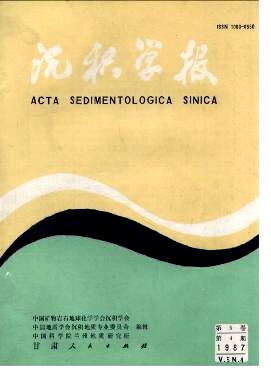STORM DEPOSITS IN UPPER CARBONIFEROUS SHALLOW MARINE CARBONATES OF JIAOZUO, HENAN
- Received Date: 1985-11-30
- Publish Date: 1987-12-10
Abstract: Storm deposits or tempestites have been recognized in Upper Carboniferious Series(Taiyuan Formation) shallow marine carbonate rocks around Jiaozuo Mines, Western Henan, in which the thickness of individual beds is generally 10-30cm, occasionally up to 50cm, and it shows a characteristic sedimentary sequence. From bottom to top they are:( 1 ) Erosional basement, which was truncated or undulated at the underlying sediments by storm induced wave and current, may show irregular variations. The wave length of the undulatory sole is about 16-40cm with 2-9cm in amplitude. In a few cases, some gutter casts-like structures would be found in the sole.( 2 ) Basal lag with normal grading limestone. The lag deposites are mainly composed of Brachiopoda, Anthozoa and Crinoidea debris with a few of whole Fusulinida, Anthozoa, Articulata, Crinoidea, Ostracoda, Estheria, Bryozoa body fossils and algae as well.( 3 ) Middle laminated unit. One or two of the sedimentary structures such as parallel lamination, wave ripple cross-lamination or hummocky cross-bedding may be recorded in the sections but varied in different depositional types. In addition, some vertical traces which are similar to escape structures may also occur within the laminated unit.( 4 ) Wackestone or Mudstone with trace fossils usually constitute the top unit of a whole storm bed. Zoophycos is the typical trace in these units and can be clearly distinguished as Z. simple form, Z. pelleted form and Z. fat form. They commonly associated with . The bioturbated bed may be subdivided into four grades depending on the bioturbation:(a) sporadic bioturbation, it only contains a few numbers of trace fossils and isolated unrecognized traces;(b) weakly bioturbated, i. e. the distinguishable and unrecognized traces are more than that of(a) in quantity;(c) medium bioturbated, in which the distinguishable traces are abundant with parts of mottled structures:(d) strongly bioturbated, chiefly consists of mottled structures which are good indicators of animal intensive activties. Apart from trace fossils, the top unit usually contains numerous body fossils such as Quasifusulina, Schwagerina, Pseudoschwagerina, Caninia, Lophophyllum, Syringopora, Dictyoclostus Choristitcs, Chonetes, Phricodothysis, Stenoscima, Magini-fera and Eomaginifera,etc. In terms of the sequence features, sedimentary and biogenic structures, four storm-generated depositional types in the limestone from Taiyuan Formation of Jiaozuo Mines are described as follows: Type A generally consists of basement lag and graded limestone in its lower subunit and the thickness is usually 2-6cm, the upper subunit is mainly wackestone(about 22cm thick) and associated with intensive bioturbation(commonly 6cm thick). The depositional water depth of this type was probably near storm wave base. Type B is composed of lower subunit recorded by basement lag and graded limestone with about 3-8cm thick, and the middle subunit(2-25cm thick) shows well developed hummocky cross-bedding or parallel laminations and the upper subunit(about 12cm thick) characterized by wackestone or mudstone and medium bioturbation as well as abundant Zoophycos. They are presumably deposited in an area near the middle-lower part between tair weather wave base and storm wave base. Type C has lower subunit(about 5cm thick) of basement lag and normal graded limestone and has upper subunit of wackestone, in which they are both lack of the laminated and bioturbated zone and it indicats that the deposited water depth was progressively shallowing and might be accumulated in the middle-upper position between fair wave base and storm wave base. Finally, type D(about 25cm thick) only includes lower normal graded coquinoid lage and upper wackestone. The trace fossils are rare or even absent, reflecting the water-depth got shallowed further, probably near the fair weather wave base in where the traces of living animal might be easily destroyed by wave or current at this environmental setting.
| Citation: | Wu Xiantao, Hu Bin, Wang Guanzhong, Zhang Guocheng. STORM DEPOSITS IN UPPER CARBONIFEROUS SHALLOW MARINE CARBONATES OF JIAOZUO, HENAN[J]. Acta Sedimentologica Sinica, 1987, 5(4): 1-13. |






 DownLoad:
DownLoad: